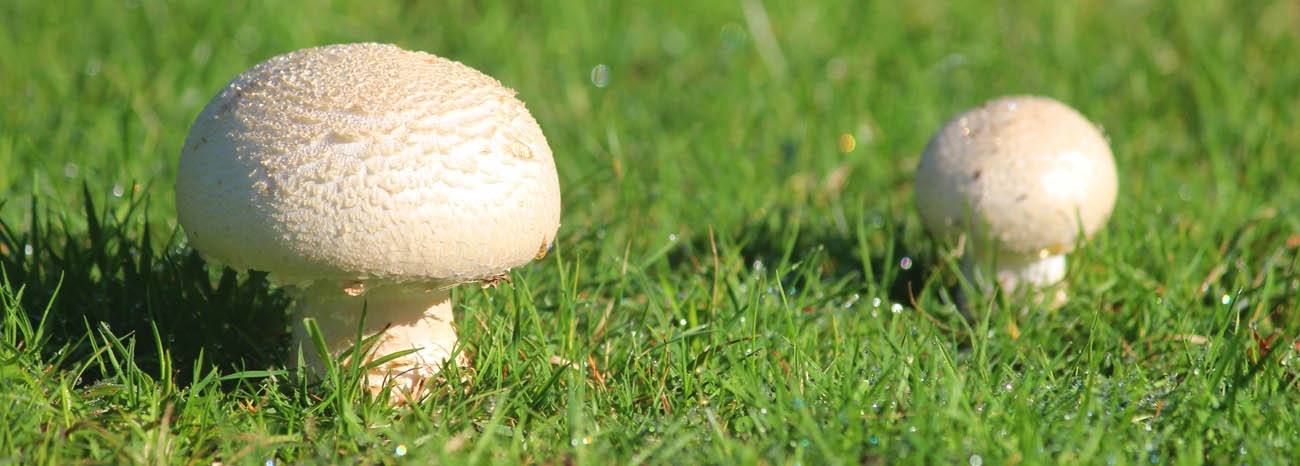If you’re noticing mushrooms popping up in your yard or around your trees every year, you’re probably wondering why. What does it mean about the health of my lawn? Are these fungi a threat to my trees? Mushrooms can be a sign of potential problems but they’re also a normal part of a healthy ecosystem. Let’s discuss why mushrooms grow in your yard, the different types of mushrooms you might find and whether mushrooms growing on your trees should be cause for concern.
Why Mushrooms Grow in Your Yard
Mushrooms are the fruiting bodies of fungi, which means they’re just the visible part of a much larger fungal network.
Here are the main reasons mushrooms might be making an appearance in your yard:
Decomposing Organic Matter
Mushrooms thrive on the nutrients provided by dead leaves, tree roots, grass clippings, and other plant matter that breaks down over time. This natural cycle is completely normal and essential for recycling nutrients back into the soil.
Fungal Networks
The fungal network that spreads under the surface of your soil is known as mycelium. It weaves through the soil, thriving thanks to the available moisture and decaying organic matter. Mushrooms are the fruiting bodies of this network.
Moisture and Shade
Because excess moisture and shade create ideal conditions for mushroom growth, you’re more likely to see them after a period of rain or in parts of your yard that don’t get much sunlight. You can see an uptick in mushroom growth if your lawn tends to stay wet, has poor drainage or if you are overwatering it.
Types of Mushrooms Commonly Found in Lawns
The mushrooms you’re most likely to see in your yard can be categorized into three broad types, each with a different relationship with the soil and surrounding plant life. Here’s more information about them and the impact they may have on your grass and trees.
Saprophytic Mushrooms
These mushrooms are mainly harmless and can even be beneficial to the soil since they feed on dead organic matter like decaying leaves and wood. Examples include Oyster Mushrooms and Chicken of the Woods (Laetiporus).
Mycorrhizal Mushrooms
Mycorrhizal mushrooms help trees and plants absorb water and nutrients more efficiently but if you see them around the base of your tree it can be a sign of decaying tree roots. Common types include Truffles and Chanterelles.
Pathogenic Mushrooms
Pathogenic mushrooms are a threat to your trees, infecting roots or wood, leading to diseased trees or decaying roots. In trees, their spores stick to the surface, penetrating through to the tissue of the tree through openings created naturally or from insect damage. A common example is the Honey Fungus (Armillaria), which can cause root rot and lead to tree death if left unchecked.
Are Mushrooms in Your Yard a Bad Sign?
For the most part, mushrooms in your yard aren’t something to worry about. In fact, they can be a sign of healthy soil.
Signs of Healthy Soil
Since mushrooms help to break down materials that can enrich your soil, seeing them in your lawn is generally a good sign. As mushrooms work to break down the decomposing matter in your lawn, they are improving the soil’s structure and nutrient content. And we know that lawns made healthy thanks to rich soil are more resilient to environmental elements like drought, disease and pests.
Potential Issues
There are some situations where mushrooms can be the first sign of an unseen problem with your trees. If you see mushrooms clustering near the tree roots, it can be a sign that water isn’t draining properly. This build-up of moisture can lead to decay in the tree’s roots or trunk, resulting in a negative impact on the tree’s health over time.
Hazardous Mushrooms
While most mushrooms in your yard are harmless, some species can be toxic, especially to pets, children and your trees. We already covered the pathogenic mushrooms that can harm your trees but there are other varieties, like the Death Cap (Amanita phalloides), that are highly poisonous when ingested and should be removed from your lawn.
What to Do About Mushrooms in Your Yard
In most cases, mushrooms growing in your lawn don’t need to be removed. They’ll disappear on their own once the moisture level drops or their food source runs out. But if you’d rather keep your lawn green and pristine or you’re concerned about their potential toxicity to children or pets, you can easily rake them up or mow over them.
Mushrooms Growing on Your Trees
It’s far more serious to see mushrooms growing on your trees than seeing them around your trees or in your lawn. This is because mushrooms growing directly on a tree is an indicator that the tree is suffering from disease or decay. The mushrooms that infect trees feed on dead wood. So when they appear, it’s a sign that the tree may be dying from the inside out.
Common Tree-Associated Fungi
- Honey Fungus (Armillaria): This aggressive fungus causes root rot and can eventually kill a tree. It usually appears first on the base of the tree, a sign that the roots are decaying.
- Shelf Fungus (Bracket Fungi): These mushrooms include species like Turkey Tail (Trametes versicolor). They grow in shelf-like formations on tree trunks and are a clear sign of wood decay.
- Oyster Mushrooms (Pleurotus ostreatus): These mushrooms are delicious in recipes when sourced from a controlled environment but they are a threat to tree health. Oyster mushrooms that grow in the wild thrive on dying or dead wood and are a sign that your tree is in trouble.
Treating Tree Fungal Infections
If mushrooms are growing on your tree, consult a certified arborist. They have the knowledge and experience to assess the extent of the damage and determine whether the tree can be saved or if it needs to be removed.
When Should You Worry?
Mushrooms in your lawn are mainly a cosmetic annoyance, as long as they’re not a poisonous species. Keep an eye on mushrooms growing around your trees but if you see them growing on your trees, it’s a sign that the tree is in declining health and it’s time to act.
The best way to reduce the number of mushrooms in your yard is to improve soil drainage. Regularly aerate your lawn and avoid overwatering. Also, regularly remove their food source—wood, leaves or grass clippings.
By understanding why mushrooms grow in your yard and how they impact your trees, you can take the right steps to maintain a healthy lawn and landscape.
We Are Here to Help
Our team of lawn care experts are here to help. If you’re not certain about the toxicity of a mushroom in your lawn or if you would like a consult with one of our certified arborists, we’re here to help. Visit emoyer.com/services/lawn-care/ or call 215.799.2016 to learn more.
FAQs About Mushrooms in Lawns and Trees
Are Mushrooms Harmful to My Grass?
Mushrooms are often a sign of healthy soil. You may not like how they look in your lawn but they can’t do any damage to your grass. Toxic mushrooms should be removed from your yard immediately as a safety precaution.
Can Mushrooms Harm My Trees?
If mushrooms are growing on a tree, it is a sign of decay and the tree may be at risk. Consult a certified arborist to evaluate the tree.
How Do I Safely Remove Mushrooms from My Yard?
Remove them by raking them out or mowing over them. If you think the mushrooms might be toxic, wear gloves.


